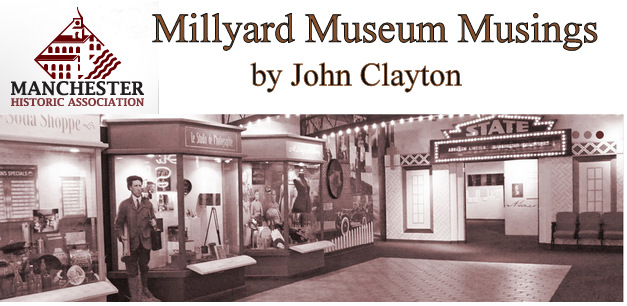
Nothing like a little city driving to put the hyper in hypertension.
Yup, nothing like five or six leisurely hours behind the wheel – let’s say on South Willow Street – to pump your diastolic pressure into triple digits, after which you won’t need Mr. Goodwrench to by-pass the carburetor and shift the internal combustion from the engine directly to your aorta.
Before you know it, you’re laying on the horn, gunning your engine, squealing your tires and making liberal use of a universally recognized hand gesture that will never, ever be mistaken for the Boy Scout salute.
Now you know how the drivers felt at the Manchester Motordrome.
On a bad day in the city, you may feel like you’re driving around in circles. These guys were driving in circles.

In their heyday – from 1947 to 1950 – midget racers buzzed around the banked, asphalt oval just south of Grenier Field on Sunday nights, emitting a roar that made Manchester a major motorhead mecca.
OK, the track was in Londonderry. What the owners lacked in geography, they made up for in their ability to market the midgets.
(In deference to the vertically impaired, I should probably point out that the term ”midget” refers to the car, not the driver, although the recent commercial success of dwarf tossing may indicate a market for munchkin motor sports).
Even though the speed and power of these tiny, open-wheel cars was enough to guarantee an audience of racing buffs, the wily promoters went one step further and dubbed them ”Doodle Bugs” – isn’t that precious? – which brought out fans who didn’t know a cam shaft from a cotter pin.
On race nights, the competition for parking spots was almost as intense as the competition on the track, which forced the Motordrome owners (George and Walter Hart and partner Bob Early) to charter buses to haul patrons up from the B&M railroad station.
”I don’t know what the capacity was, but the place was packed every night they raced,” Joe Pichette told me a while back. ”My brother and I would shoot up there early to beat the crowds and park at the farm across the street. We used to go bananas watching those cars.”
”By the third year, they charged a buck apiece and they’d get 8,000 people in there,” added Dick Pellerin, who kept a midget racing scrapbook as a kid. ”The winner of the feature race would probably get $25 and a silver cup, so someone was making some serious money.”
And it cost some serious money to keep cars on the track. Emotions ran as high as the RPMs, so a typical 50-lap, chassis-trashing duel between Bud Tatro and Joe Sostilio was murder on the midgets, which sometimes weighed as little as 500 pounds.
Lack of size did not mean lack of power, however, especially after the advent of the Offenhauser engine. A methanol-fueled Offy with a dual-overhead cam went for $3,500 – how’s that for macho race track chatter? – but it was a necessary expense if you wanted a piece of the purse.
As with any sport, the drivers developed loyal legions of followers. Glossy photos of the stars in their cars were swapped and traded like so many baseball cards, and those old photos turned up regularly in issues of ”Front Stretch,” a newsletter once produced by Bob Stevens of Nashua for the preservation of auto racing history in New England.
While the current NASCAR circuit has spawned such legends as Jeff Gordon, Kyle Busch and Dale Earnhardt, Jr., the Manchester Motordrome had its own colorful cast. Local drivers like Ken Littlefield of Concord and Ed ”Cigars” Eng of Nashua – he never drove without a stogie – went head-to-head with unforgettable characters like ”Dynamite” Bill Dugan, ”Wild” Bill Randall, Fred ”Meatball” Orlando, and ”Bronco” Bill Schindler, who was known to some as ” One-Legged ” Schindler.
”But he would have punched you in the nose if he heard you call him that,” said former State Trooper and longtime midget racing aficionado Herb Bean.

According to a 1947 article by my storied predecessor, Walter F. Healy, good ol’ One-Legged Schindler ”had his leg snipped off in a race-car crack-up, but his face barely shows the fancy hem-stitching of surgical thread that has tied together his ripped and torn flesh.”
Under today’s conditions, a race car driver who had lost a lower limb wouldn’t have a leg to stand on – hmmm, maybe that’s not the right phrase – but since he was driving a midget racer, Schindler’s loss was negligible.
”Since midget cars didn’t have a clutch or a brake pedal, the only foot you needed was for the accelerator and the only thing you had to do with it was push down hard,” said Herb Boyce, who took his Motordrome memories with him years ago when he moved from Manchester to Safety Harbor, Fla.
Sad to say, Schindler died behind the wheel in 1952 on the track in Allentown, Pa., but death was no stranger to midget races. The aforementioned Ed Eng met his maker in Jacksonville, Bill Randall bought the farm at Lime Rock, and then there was Johnny Thompson.
Ardent race fans fondly remember Johnny tearing up the track at the Manchester Motordrome before he graduated to fame and fortune at the Indianapolis 500. In his eight appearances at Indy, Johnny’s best showing came in 1959 when he won the pole position and captured third place, but a year later, like Schindler, Thompson’s career was cut short at Allentown.
One problem with the midget cars was the complete exposure of the driver’s head and shoulders, and I’m not talking about shampoo. Without a roll bar, the only protection available to drivers was pair of aviator goggles and a helmet of compressed paper – honest – called a Cromwell, so the most innocuous accident was potentially fatal.
Although you can still catch midget racing in venues like Monadnock Speedway in Winchester or at Star Speedway in Epping, the midget spectacle ended in Manchester after three short years. Motorcycle races filled the void for a time and then the rough-and-tumble stock cars made celebrities out of local jalopy drivers like Dick Ford, Ollie Silver, Archie Archambault and Lucien ”Cannonball” Lavigne. In recent years, the Manchester Motordrome even found new life as a go-kart track, but for so many years after the original midget heyday, the old track surface was simply broken and scarred.
Like so many of the men who drove upon it.

John Clayton is Executive Director of the Manchester Historic Association. You can reach him with your historical (or existential) questions at jclayton@manchesterhistoric.org.
 You’re one click away! Sign up for our free eNewsletter and never miss another thing.
You’re one click away! Sign up for our free eNewsletter and never miss another thing.







